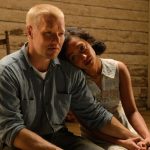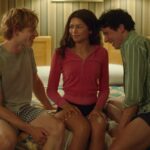Joyce Glasser reviews The Bikeriders (June 21, 2024) Cert. 15, 116 mins in cinemas
Jayne Russell and Marilyn Monroe claimed to be just two little girls from Little Rock in Gentlemen Prefer Blondes, but director-writer Jeff Nichols (Loving, Mud, Take Shelter) is the real thing. And so are the characters in his new film The Bikeriders, inspired by the raw black and white images in photo-journalist Danny Lyon’s 1968 book of the same title. If UK bike riders are Lycra lads jumping red lights on Colnago V3Rs, Nichols’ bikeriders, albeit from greater Chicago, are descendants of Marlon Brando as Johnny Strabler driving into a small town on a noisy Triumph Thunderbird in the iconic 1953 film, The Wild One, released in the same year as Gentleman Prefer Blondes, but banned in the UK for fourteen years.
In The Wild One, the scene when the brooding, drop dead gorgeous leader of the pack Johnny (Brando), encased in black leather asks the small town café-owner’s innocent daughter Kathie to a dance could qualify for an X rating. Nichols just about recreates that frisson. His Kathy, spelled with a y and played by Killing Eve star Jodie Comer with an American regional accent, creates a stir walking into a crowded biker bar to meet a girlfriend.
In a bit of foreshadowing of a future near-rape scene, Johnny (the wonderful Tom Hardy in an off-kilter homage to Brando), observing her discomfort at being cornered by a mangey bunch of hungry animals, sits at Kathy’s table in an early power play, masquerading as a rescue. He introduces himself as president of the club – The Vandals – and promises he won’t let anything happen to her.

But something does happen, and there’s no saving her. When Kathy’s darting eyes land on Benny (Austin Butler) a dreamily handsome, lean young man leaning on the pool table in a low-cut undershirt with a thick mane of dirty blond hair, his sex appeal takes her – and our – breath away. Before she can withdraw her gaze, he’s onto her. Like the original Kathie, this one senses danger in the attraction, and declines his quiet invitation for a date. She exits the bar with the hairy bikers’ handprints visible on her white jeans.
It’s not Johnny, but his protégé, Benny who is already waiting outside on his bike to rescue her. When Kathy silently climbs on the back of Benny’s bike there’s no going back. Within 48 hours her live-in boyfriend is gone. ‘Five weeks later I married him,’ she tells photo-journalist Danny Lyon (Mike Faist – who played Riff from The Jets in Spielberg’s West Side Story).
The real Danny Lyon embedded himself in a gang a lot more dangerous than the Jets when, between 1963 and 1967, he followed the Chicago chapter of the Outlaws Motorcycle Club, living and riding alongside them and recording their lifestyle in his 1968 picture book.
Nichols continually reminds us that Danny is filming and recording the action and the fireside conversations of the members, who, mellowed by booze and the adrenalin-release of a good fight, talk about themselves, misfits all. All of the members have character traits, but you can identify Benny, Johnny, Cal (Boyd Holbrook), Zipco (Michael Shannon) and Cockroach (Emory Cohen) from Danny Lyon’s 1968 photo book. This authenticity is achieved by such details as Cockroach’s fondness for eating bugs, a detail that few scriptwriters would dream. Similarly, when, in the film, a member is killed in a traffic accident, the gang defy the request of the bereaved family not to send flowers or attend the funeral.
Along with tracing the story of the fictional Vandals, modelled after the Outlaws, the film is structured around the battle between Kathy and Johnny for the body and soul of the noncommittal wild one, Benny. Kathy knows she is losing when, concerned for Benny’s life, he ignores his doctor’s orders and her ultimatum and joins Johnny at a big drunken club picnic. Benny answers to no one. When Kathy pleads with him to leave the club, complaining, ‘I can’t live like this anymore,’ he warns her ‘don’t ask me that.’ She confesses to Danny that she was too much in love to call his bluff.

But this independence works both ways. At the picnic, Johnny asks Benny to be his successor because none of the other guys have the guts to command the respect the leader needs. Johnny refuses. The relationship between Johnny, a truck driver with a neglected wife and children, has echoes of Prince Hal and Falstaff, with Hal/Benny rejecting the close bond he has felt for his much older mentor.
Like Hunter S. Thompson, who lived with the Hell’s Angels for a year for a magazine article (and ultimately, his book Hell’s Angels: The Strange and Terrible Saga of the Outlaw Motorcycle Gangs) Lyon, too, feared the group’s capriciousness as well as the new members who preferred drugs to beer and guns to fists. In the film, the ousting of the old guard by the far more violent and criminal new members, is epitomised by the Kid (Toby Wallace), a proud psychopath who, rejected by Johnny, the man he once idolised, outplays him at Johnny’s own game.
The film looks beautiful thanks to Nichol’s regular cinematographer, Adam Stone, and the atmospheric sound track defines the era. The characters and group dynamics are well drawn, but the film drags in the meandering middle section, and Cromer’s great performance is let down by the absence of her character’s backstory. More than once she tells Lyon how she, her way of thinking and her life changed beyond recognition after years with the club, but we never see how it changed as her family is kept at bay and we know little about her before she joined the club.
What began as a romantic, anarchistic adventure, ended in disillusionment for Hunter S. Thompson (who witnessed wife beating and was himself beaten up); for Lyon (who was horrified by Nazi symbols in the group), and for Benny who finally balks at Johnny’s tactics of cruelty. When Johnny claims he ‘took care of Cockroach’ who needed a lesson, Benny asks, ‘like you took care of Kathy?’ referring to Johnny’s failure to protect Kathy from a sexual assault.
This is the trajectory of the narrative, such as it is, which could be subtitled, the Rise and Fall of the Vandals. In an early scene we see Benny winning a race with the police by jumping five consecutive lights. When he breaks free onto the open highway there’s a grin on his face, that quickly fades when he runs out of gas as the sirens catch up. This grin foreshadows another that comes at the brilliant end of the film when that smile returns shrouded in ambiguity.




